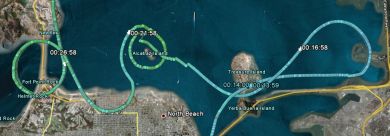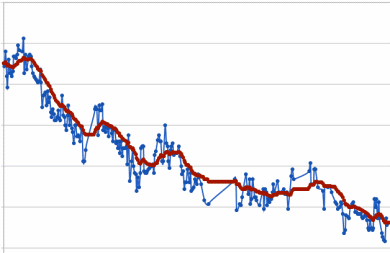|
One of the fun things about flying is you get to accessorize. Bags, electronic gizmos, etc. Here's some products that I've found helpful. Some of this is flying specific, but not all of it.
Another fun flying lesson today, spin recovery training. A
spin is a
terrifying
flight maneuver where the wings are stalled, you're pointed down towards the
ground, and the plane is spinning out of control about once a second. You never
want to go anywhere near a spin in ordinary flight, it's a good way to end
up dead fast. But in the right plane with a pilot who knows what he's doing
a spin is kinda cool.
Spin training is a bit controversial in flight instruction. It's no longer required because too many students (and instructors!) killed themselves trying it. And spin recovery training isn't clearly useful; the most likely circumstance where you'd spin by accident is at takeoff or landing where you won't have enough altitude to recover anyway. So flight training is focussed instead on recognizing when a stall is about to occur and recovering before a spin ever develops. But I wanted to try spinning to get a sense for what's over the horizon, how much further you can push a plane and live to tell about it. Also, spinning a plane turns out to be super fun. Queasy, dizzyness-inducing fun, like a rollercoster. But I have new confidence having learnt how to recover from a challenging flight condition. I hope never to spin a plane again, but now I know what it's like. The most fun part of my lesson turned out to be flying the Super Decathlon, the aerobatic plane we used for spin training. I've been learning in Skyhawks, the minivans of aviation. Big, comfortable, good for travel, and mushy clumsy handling. By contrast, the Decathlon is a little sporty coupe. My first turn surprised me; I was only beginning to think about turning when we were already in a 30° bank just perfect for making that turn. Very fun flying something so nimble.
We've had crummy weather the last few weeks. Cloudy, or rainy, or windy. So yesterday's perfect weather was welcome for a long flight lesson. Starting with a San Francisco Bay Tour, then some practice instrument flying, emergency landing practice, dinner at Santa Rosa airport, and a long night cross country flight back to San Carlos via Petaluma and Byron. A lot of flying instruction for one day and a lot of fun. I felt like a real pilot.

After a nice dinner at the Santa Rosa airport we took a long cross-country flight back to San Carlos to meet my 100nm requirement. Flying at night is hard, particularly with no moon, and I made it harder on myself by choosing smaller airports and navigating without the GPS. Good practice with the instructor, but I think night flying is something I'll be very cautious about until I get more experience. I'm getting close to the end of my private pilot license preparation. If all goes well I should be ready to take my checkride in about six weeks; main things are solo cross-countries and improving the precision of my airwork and performance takeoffs and landings.
Last year I got serious about trying to lose some weight. After literally a lifetime of neglecting my diet and exercise I was tired of getting fatter. So I've been paying attention for the last year and have lost 20 pounds. And I feel good about what I'm doing, think I can sustain it. My goal has been a permanent lifestyle change, not a temporary deprivation; so far so good.
 The two steady drops at the start of the graph (8 pounds and 5 pounds) came from calorie counting, with a predictable 3 pound gain in the middle when I took a trip. Counting calories really helped me pay attention to what I was eating, to learn to moderate. But it's a daily bummer and a pain, so eventually I gave up on it. I didn't do any specific dieting again for a few months but still managed to keep a steady weight. Then a few months ago I started deliberately limiting carbohydrates, particularly sugar, inspired by Good Calories, Bad Calories. That seems to be working for me, another 6 pounds, and it feels sustainable. I'm skeptical of the low-carb fad of the last decade but having a salad instead of french fries and avoiding fruit juice and coke seems to make a difference. The one thing I'm not doing is getting more exercise. Honestly, I'm just lazy. Biking is the only exercise I ever did sustainably but San Francisco is actively hostile to bikes. But I need to find something physical to do, for my health if not for weight loss. Fun aviation fact: every pound I lose is another minute of fuel I can carry in an airplane.
I need some help. How do I migrate this blog with content intact to a modern blog host? Mail me if you have advice.
This blog has run for 8 years on Blosxom, hosted on a private Linux box. It's worked great, Blosxom really is a marvel of simplicity. But the world has moved on. I'm sick of editing HTML text and I'm tired of paying $120/month for a server that no longer does anything but run this blog. So I need to migrate my blog to a new platform. A hosted platform, specific for blogs, I don't want to administer software. Where should I go? My secret gaming blog is hosted on TypePad, which works pretty well, but the editor isn't always well behaved on Google Chrome and I don't always like the way it emits HTML and manages assets. WordPress is the other contender, but my previous experiments with it didn't quite feel right. Tumblr is awfully cool but doesn't seem suited to essayists. It pains me not to even consider Blogger, but years of neglect at Google have taken their toll. Really any of these platforms would do fine. What I care most about is a bit of control: I don't want a lot of garbage markup and template weirdness. The harder problem is content migration. I've got 1400 blog posts, mostly formatted in naked HTML but with some occasional weirdness. And a custom stylesheet. And 800 images. I had some luck getting Blosxom to emit MovableType's import format but a lot of formatting was broken. And image migration is a challenge. Any suggestions? I've been meaning to do this for six months and gotten nowhere. Please mail me: I'll summarize any suggestions with credit.
Ars Technica recently published a good overview of air traffic control technology. A few weeks back I got to visit Norcal TRACON, the central hub that controls the airspace around the Bay Area, Sacramento, soon all the way to Reno. The visit was really cool, I left with a real respect for the skills of the controllers. Also impressed by the technology. Relatively simple but highly customized user interface for the main radar scope display with lots of good human factors design. And similarly simple-but-customized auxiliary information displays, communications, etc. It all seemed very functional.
When I was first learning to fly the controllers intimidated the heck out of me. They were literally the Voice of Authority, they were speaking a special language, they were interrupting my concentration, and I was afraid I'd say something dumb and embarass myself. I'm entirely over that now. A key experience was at Palo Alto with a trainee controller in the tower. I was practicing landings and the tower kept screwing up, at one point even clearing me to taxi on to a runway someone was landing on! No danger: the supervisor immediately corrected the clearance and I wasn't going to taxi into the airplane I could see, anyway. But it was all a good lesson that the controllers are people too and that they're there to help me, not enforce regulations. You also get to know voices and they're quite friendly and helpful when able. It's a good relationship. ATC has been in the news lately with the story of a controller letting his kids give instructions on the radio. It's been way blown out of proportion, I can't imagine there was any conceivable threat to safety. But there's appearances to maintain and apparently will be hell to pay for a father showing kids his pride in his work. It's a shame: one of the things the TRACON guys told me was they're having a very hard time training new controllers. All the folks hired in 1981 after Reagan busted the union are reaching mandatory retirement age. They're trying to recruit more controllers and accelerate training, but it's not working out as well as they need. After this mess the ATC job must just look all the less appealing. I have absolute trust in the controllers who have helped me, they deserve a little slack and the ability to exercise their own judgment.
I have a love/hate relationship with Apple products, particularly my beloved iPhone. Today Apple proudly announced they're suing HTC over phone patents: that's firmly on the hate side.
We can sit by and watch competitors steal our patented inventions, or we can do something about it. We've decided to do something about it. We think competition is healthy, but competitors should create their own original technology, not steal ours. Everyone in the tech industry knows the patent system is entirely broken. Other than a few sleazy actors like Intellectual Ventures there's an understanding in the innovative side of the tech business that you don't file aggressive patent lawsuits. You write a lot of patents, you file defensive lawsuits and countersuits, but in general you don't use your patent portfolio as a big club to try to destroy competitors. Apple's taking a big crap on that detente. It's pretty hard to love a company that is going to exploit the broken patent system to stifle innovation. Not that this is new misbehavior, see also Apple's 1988 look and feel lawsuits. What's particularly galling is Jobs' language about "stealing". We'll know more when the patents are named, but I have to wonder. Does he think anyone else using a multitouch UI is stealing? Pinch-to-zoom? Seamless wifi/cellular networking? I wonder if Jobs called it "stealing" when Apple took the mouse and windowed GUI metaphors from Xerox? |
||
